#museo do prado
Explore tagged Tumblr posts
Text
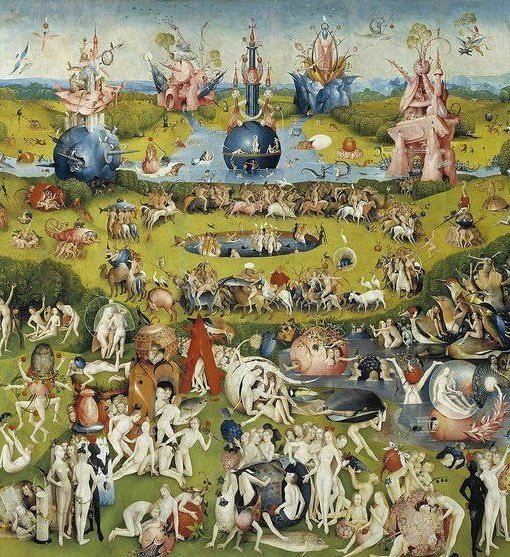
Bosco: Xardín das Delicias
97 notes
·
View notes
Text
ARTE EN LA RED: LA GIOCONDA O MONNA LISA
ART ON THE NETWORK: LA GIOCONDE OR MONNA LISA EDGAR AWAD V. Columnista El retrato de Lisa Gherardini, esposa de Francesco del Giocondo, más conocido como La Gioconda o Monna Lisa, es una obra pictórica del polímata renacentista italiano Leonardo da Vinci. Obra que fue adquirida por el rey Francisco I de Francia a comienzos del siglo XVI y desde entonces es propiedad del Estado francés. Se…

View On WordPress
#ACERCA DE LEONARDO#ARTE EN LA RED#DOS MONAS LISAS HECHAS POR LEONARDO#EDGAR AWAD COLUMNISTA DE LA AGENCIA MUNDIAL DE PRENSA#EL ROBO#ESPECIFICACIONES TECNICAS#LA GIOCONDA#LA MONA LISA#leonardo da vinci#lomasleido#MONNA LISA#MUCHAS MONAS LISAS#MUSEO DE LOUVRE#MUSEO DEL PRADO#PRECIO#SIMBOLISMO#VANDALISMO
0 notes
Text
“From birth I was cast upon you; from my mother's womb you have been my God.
Do not be far from me, for trouble is near and there is no one to help.” - Psalm 22
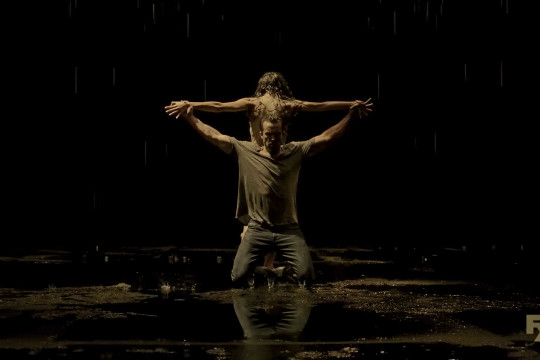




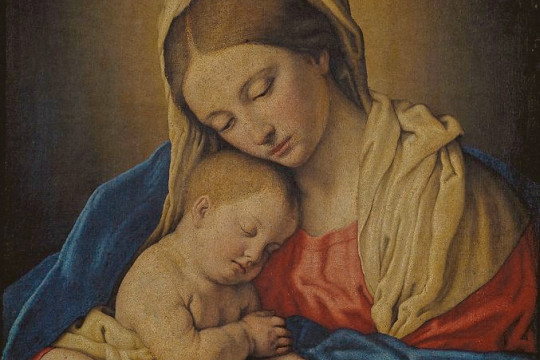
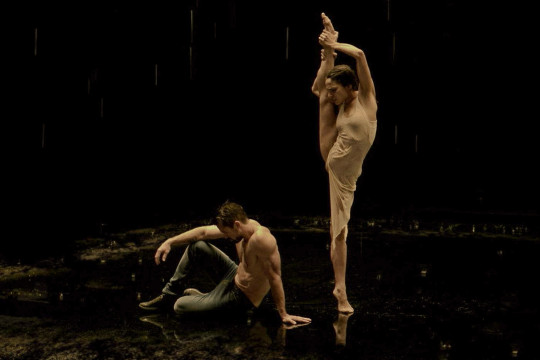



1. Velázquez, Diego. Christ Crucified. 1632, Museo Del Prado, Madrid.
2. Barbieri, Giovanni Francesco. Apparition of Christ to the Virgin. 1628 - 1630, Civic Art Gallery, Cento.
3. Sassoferrato, Giovanni Battista Salvi. Madonna and Child. 1625 - 1700, Louvre Museum, Paris.
4. Story, William Wetmore. The Angel of Grief Weeping Over the Dismantled Altar of Life. 1894, Rome.
5. Bloch, Carl Heinrich. The Crucifixion. 1870, Museum of National History, Copenhagen.
6. “Mac Finds His Pride.” It's Always Sunny In Philadelphia, season 13, episode 10, FX Network, 7 Nov. 2018. Writ. Rob McElhenney and Charlie Day. Dir. Todd Bierman.
#im sure someone else has already done this#but#here's more#it's always sunny in Philadelphia#always sunny#iasip#mac mcdonald#mac sunny#mac finds his pride#there is one common theme in all the images i chose#and that is#helplessness#rob mcelhenney#rcg
946 notes
·
View notes
Text

Isabel II and Her General Staff, on Horseback
Artist: Charles Porion (French, 1814-1884)
Date: c. 1862
Medium: Oil on canvas
Collection: Museo del Prado, Madrid, Spain
Description
This large-format group portrait is an ideal representation of the General Staff of the Spanish Army. In the centre of the composition Queen Isabel II, dressed in the uniform of captain general, wearing the Golden Fleece around her neck and the band of the Grand Cross of the Order of Charles III with its scallop shell across her chest; on her chest and under her lapel two other Grand Crosses can be seen, that of Charles III and Isabel la Católica (Project cataloguing heraldic and phaleristic elements, Royal Academy of Heraldry and Genealogy of Madrid).
The queen heads the cavalcade accompanied by her husband Francisco de Asís de Borbón y Borbón Dos Sicilias , also dressed as a captain general, and by Francisco de Paula , infante of Spain . Accompanying the young queen, Porion portrays some of the military men who took part in the final days of Isabel II 's government: Narváez, O'Donell and Prim, who appear prominently alongside other generals who had already died at the time the work was created, such as Digo de León and Palafox.
#group portrait#general staff of the spanish army#queen isabel ii#uniform#captain general#golden fleece#cavalcade#francisco de asis y borbon#francisco de paula#military men#spanish history#oil on canvas#landscape#horses#oil painting#artwork#charles porion#french painter#spanish culture#european art
24 notes
·
View notes
Text
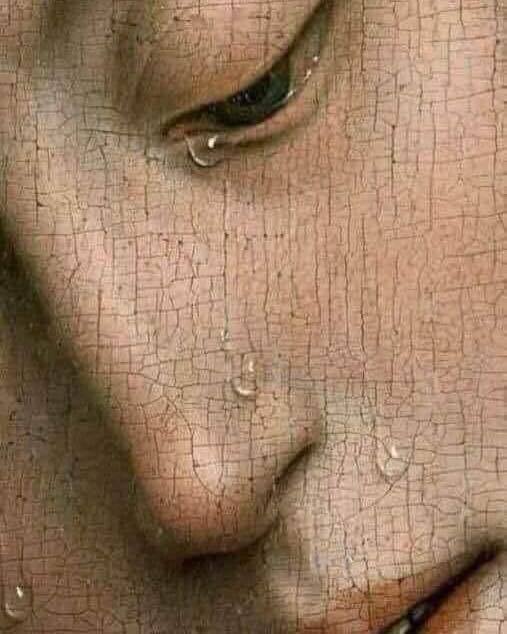
Rogier van der Weyden (Flemish, 1399 - 1464) Descent from the Cross (Ca-1435) Museo del Prado, Madrid, Spain
* * * *
"Each time you feel the beginning of weakness, relax and then think seriously: “I wish the result of my weakness to become my own strength.” This will accumulate in you for your future work. Each man knows which weakness he has in him. Each time this weakness appears in you, stop yourself and do this exercise." ~ Gurdjieff (Meetings 1941-46)
[Thank you Ian Sanders]
[via "Alive On All Channels"]
#Rogier van der Weyden#Descent from the Cross#Museo del Prado#Madrid#Gurdjieff#Ian Sanders#quotes#loss#weakness#grief#strength#feeling#felt sense
115 notes
·
View notes
Text

José María Casado del Alisal (Spanish, 1832-1886) Los dos caudillos, 1866 Museo Nacional del Prado, Madrid
This painting shows how the Great Captain Gonzalo Fernández de Córdoba found the body of his adversary after the famous battle for control of the kingdom of Naples, fought during the times of the Catholic Monarchs. The page, who is still holding the body of his dead lord, looks imploringly at the Spanish hero. The painter clearly captures the respect of the victor towards the defeated, to whom the appropriate funeral honors were paid.
#José María Casado del Alisal#Spanish history#historical art#spanish#spain#spanish art#los dos caudillos#the two leaders#war#war painting#1866#1800s#art#european art#fine art#classical art#europe#european#oil painting#fine arts#europa#mediterranean#Gonzalo Fernandez de Cordoba#medieval#medieval europe#medieval history#castille
30 notes
·
View notes
Text

Noli Me Tangere
Artist: Antonio da Correggio (Italian, 1489–1534)
Date: c. 1525
Medium: Oil on panel
Collection: Museo del Prado, Madrid, Spain
Description
Mary Magdalene wears the yellow garb characteristic of prostitutes and appears deeply moved by the meeting. Her emotional instability contrasts with Christ's serene, tranquil figure, which Correggio depicts with a few iconographic peculiarities, including a blue robe in contrast with the white or pink robes traditionally employed in illustrations of this passage from the Bible (John 20:1-19) . Correggio's color choice alludes to the sky or to the absence of stigmata from Christ's Passion, symbolizing his perfect state after the Resurrection.
Noli Me Tangere - Touch Me Not
Jesus tells Mary, “Touch Me not” (John 20:17, KJV); but then later, speaking to Thomas, He says, “Reach hither thy finger and behold My hands; and reach hither thy hand, and thrust it into My side” (verse 27). The seeming incongruity of Jesus’ statements is resolved when we examine the language Jesus employed and consider the basic difference between the two situations.
In John 20:17, the word translated “touch” is a Greek word which means “to cling to, to lay hold of.” This wasn’t just a touch; it was a grip. Obviously, when Mary recognized Jesus, she immediately clung to Him. Matthew 28:9 records the other women doing the same thing when they saw the resurrected Christ.
In loosening Mary’s hold on Him, Jesus was, in effect, saying this: “I know you desire to keep Me here, always present with you. I know you want everything to be just the same as before I died. But our relationship is about to change. I’m going to heaven, and you will have the Comforter in My place. You need to start walking by faith, Mary, not by sight.”
When Jesus spoke to Thomas, it was not to counter a misplaced desire but to rebuke a lack of faith. Thomas had said he would not believe until he had touched the living body of Jesus (John 20:25). Jesus, knowing all about Thomas’s declaration, offered His body as living proof of His resurrection. This was something He did on another occasion as well (Luke 24:39-40).
So, both Mary and Thomas needed more faith. Mary needed faith enough to let Jesus go. Thomas needed faith enough to believe without empirical proof. Mary needed to loosen her grip; Thomas needed to strengthen his. The resurrected Christ gave both of them the faith they needed.
#painting#christianity#mary magdalene#resurrected christ#landscape#bible scene#bible scriptures#noli me tangere#biblical art#holy bible#jesus#christ's resurrection#antonio de corregio#italian painter#italian renaissance#16th century painting#artwork#museo del prado#oil painting#european art
13 notes
·
View notes
Text
I don’t feel like our love is brand new. There must have been lovers, soulmates, before us, experiencing what we get to have. And it’s giving me comfort to imagine there will be many more like us to come. Our kind of love is the kind of love that makes this rotten world worth living in.
prince simon in madrid
a pilgrimage along the world that @prince-simon created 🥹
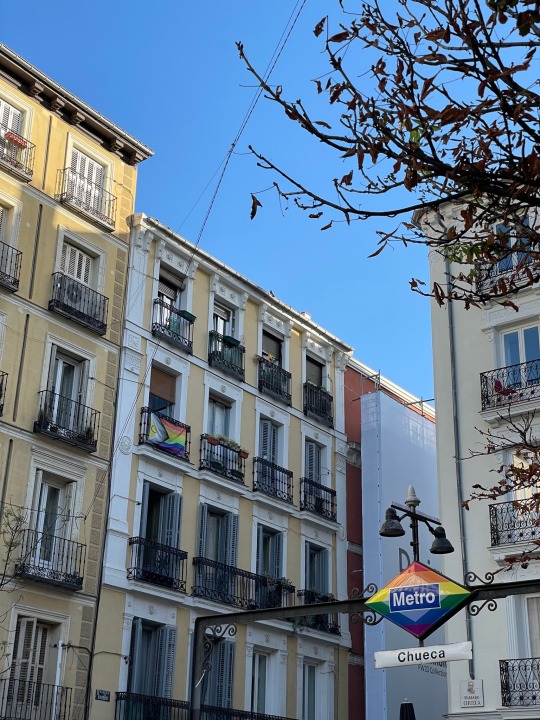
Simon’s neighbourhood, Chueca
“It’s actually the Queer Neighbourhood of Madrid, and coincidentally also where I live.” He lowered his voice as if to tell a secret, “It’s actually not a coincidence at all.” (chapter 2)
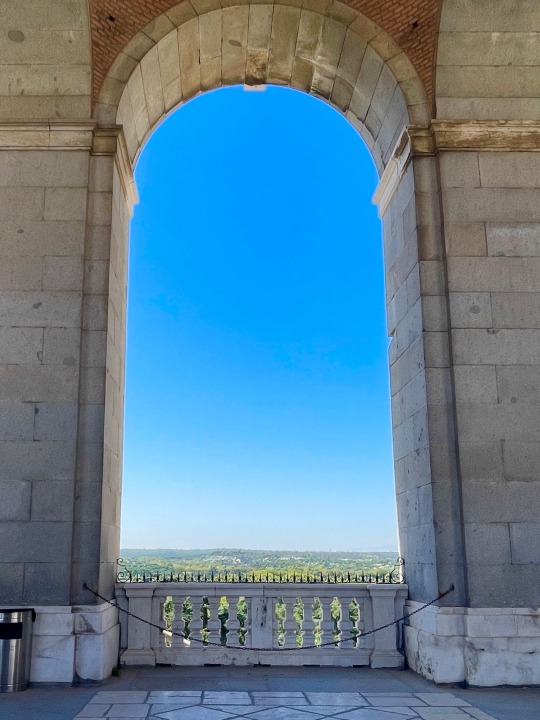
Casa de Campo (view from the Royal Palace lol oop)
Wilhelm didn’t even recognise himself. He didn’t think he’d ever looked that happy. And Simon… his eyes were closed and his curls were a mess and Wilhelm had never seen anyone more beautiful. (chapter 3)
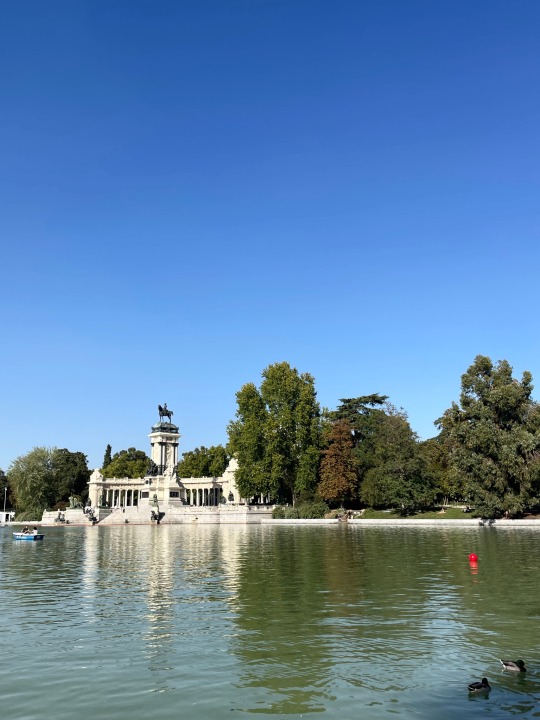
El Retiro
Simon looked at Wilhelm much too adoringly for a statement this goofy. “The ducks are gay!” He yelled at Santiago and Paula, “Just so you know!” (chapter 9)
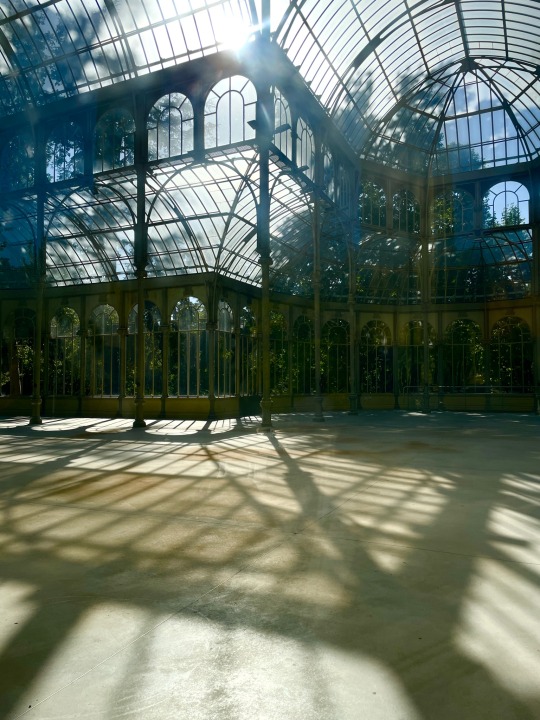
Palacio de Cristal
“Here’s a funny thought - bear with me, okay? But just imagine. Flowers. Everywhere, like on the ceiling, up the walls. Fairy lights scattered all through it. It would be so gorgeous as a- uh, like. For a wedding…�� Realising where his train of thought had gotten him, Wilhelm fell quiet, looking at Simon with wide eyes. (chapter 9)
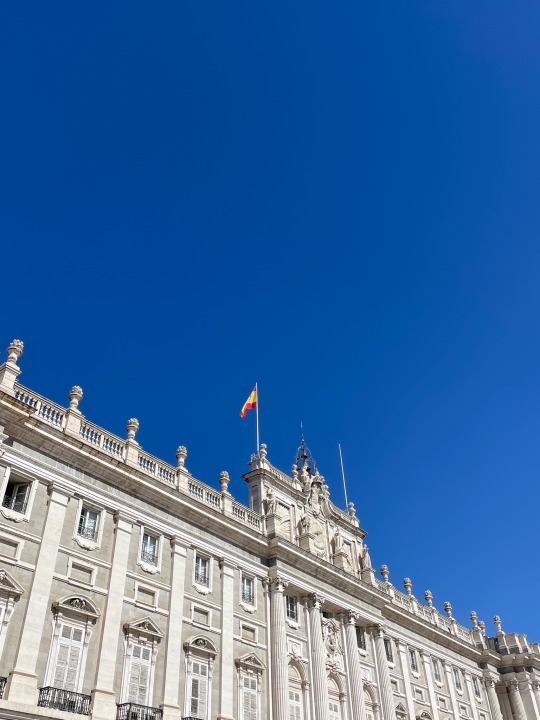
El Palacio Real de Madrid (more specifically the Throne Room lmfao)
Simon traced his fingers over the bruises on Wilhelm’s neck and in the opening of his dress shirt, humming contentedly. Wilhelm followed the movement in the mirror, and marvelled at how good they looked together, how well they fit together and how much Simon belonged right here – on the throne, with Wilhelm. He deserved the world and so much more. (chapter 12)
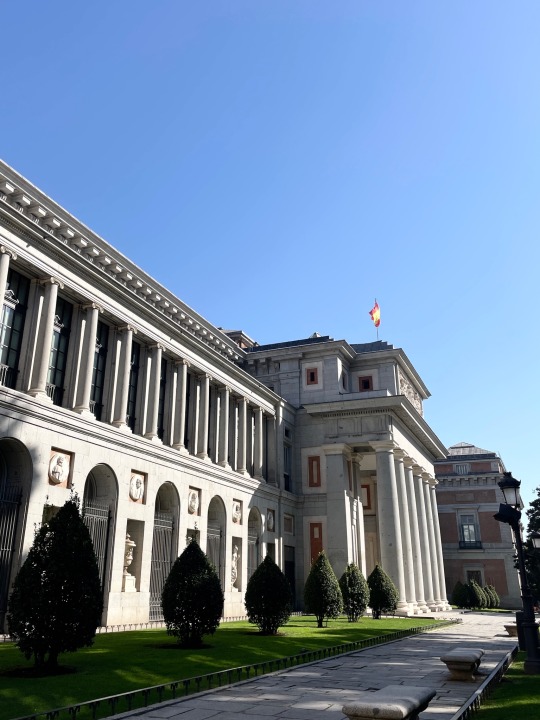
Museo Nacional del Prado
Around them, the other visitors kept moving, admiring the art on the walls, and for the moment Wilhelm felt infinite, imagining himself a painting, looked at and analysed hundreds of years from now. El Abrazo de los Príncipes.

Lo Spasimo, Raphael, 1515-1517
“Are we allowed to kiss in front of Jesus on his way to crucifixion or is that tasteless? Because I really want to kiss you right now, Simon.”
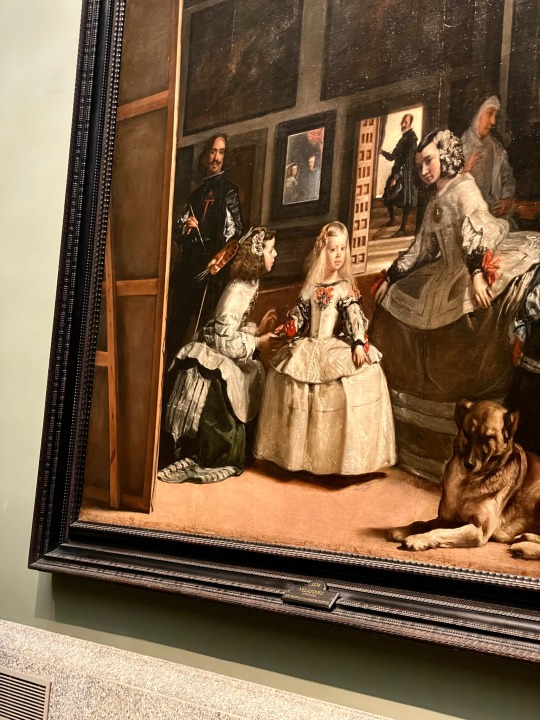
Las Meninas, Diego Velázquez, 1656
“He made me look at Velázquez in the painting and how he was looking back at the viewer, at me. I still remember the exact tone of his voice, how he was so certain when he told me that I had every right to be where I am. That I am the subject of this painting, the king being painted. All those tyrants, King Felipe and Emmanuel and all those that came in between, they are trapped in that mirror forever while I am here, alive, we’re here. Velázquez is looking at two queer princes, ready to paint us.” (chapter 13)
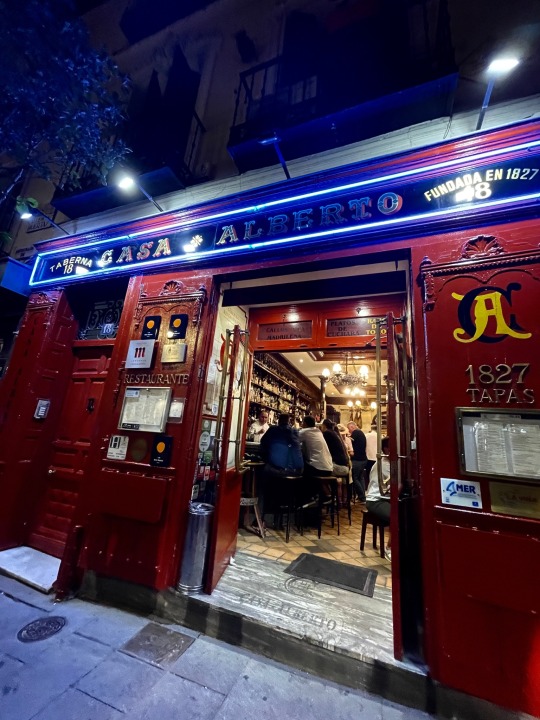
Casa Alberto
“So, tell me more about this special part of Madrileñan history.” He was slightly teasing but mostly actually curious.
Simon seemed all too eager to answer that question, and it hit Wilhelm how genuine Simon’s care for his city — his country — and its people was. It made him a little sad to know that a lot of people didn’t get to see that because they only focused on Simon being too gay or too Latino, or even just too carefree and enjoying life because he was young, to be their future king.
bonus content:
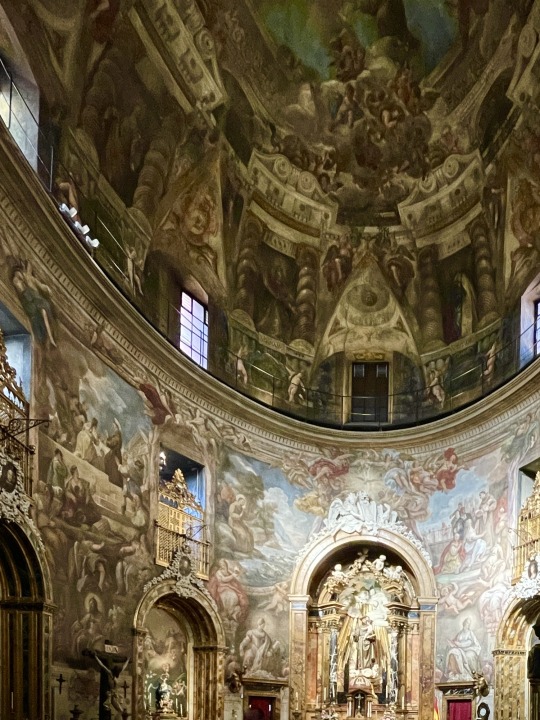
Iglesia de San Antonio de los Alemanes (where Simon goes to church)
“I think I need to go somewhere.”
“Oh?” Wilhelm said softly, “Right now?”
Simon hesitated before he nodded. “I need to- get some clarity? Or - I hope that I’ll get it there?” He whispered, voice shaky.
“Do you want to tell me where you’re going?”
“To- uh, to pray? I mean- to church? I don’t know if I’ll pray…” Simon’s voice was shaky, uncertainty shining in his eyes when he dared to look up at Wilhelm. (chapter 11)
#god i don’t think i have immerse myself into a fictional world so deeply before#this story lives and breathes#and i love what it has given me god to imagine when i read the first chapter i have not moved countries or gotten a cursed degree yet#he feels like a friend i held by the hand and walked through adventures together🥹#i really went to a particular restaurant and ordered particular dishes because i read about it in a book#and it was as magical as i imagined heheh#(including the snails sksksk)#prince simon i love you forever#prince simon au#prescribing everyone a reread Right Now!#give me attention and i’ll come back with extra pics of the food sksk#simon’s depression church is not mentioned in Text but this is canon source hehe#i’m not the first person to visit pscu locations and i love everyone who’s done it what a great idea it was so fun!#yes i know you’re not supposed to take photos in the prado but then i remembered this was built by a colonial powerhouse then felt less bad
48 notes
·
View notes
Text

Número de catálogo: P006895
Autor: Ximénez, Miguel
Título: San Miguel Arcángel
Fecha: 1475 - 1485
Técnica: Técnica mixta
Soporte: Tabla
Dimensión: Alto: 123,5 cm; Ancho: 60,8 cm
Serie: Retablo de la iglesia de Ejea de los Caballeros, Zaragoza
Procedencia: Iglesia parroquial de Santa María de Ejea de los Caballeros, Zaragoza; adquirido para el Museo del Prado, 1982.
San Miguel arcángel, representado como joven caballero vestido con armadura cuatrocentista, clava la lanza a Satán, que, rendido a sus pies (Apocalipsis XII, 7-9) en figura de dragón, intenta inútilmente liberarse del arma que lo atraviesa. La brillantez de los colores empleados, rojo, verde, negro, y la abundancia de oro como adorno del nimbo y de los atavíos, colaboran eficazmente en la belleza de la obra. Dada su gran fama como guardián terrenal y salvador de almas, san Miguel se convirtió en patrón de comunidades y personajes de toda condición, siendo uno de los personajes celestes más representados de la pintura gótica española.
Esta tabla constituía la calle lateral izquierda del cuerpo de un retablo dedicado al tema de la Piedad (140 x 81 cm), con la figura de la Virgen María, sedente sobre un altozano, contemplando llena de dolor el cuerpo de su Hijo muerto, yacente sobre su regazo, como resumen de la Pasión. La calle lateral derecha se dedicó a Santa Catalina de Alejandría (P6895), de notable popularidad durante la Baja Edad Media. En el banco del retablo (P2519) se representaron cinco escenas (70 x 40 cm cada una), de las que cuatro se dedicaron a plasmar pasajes de la leyenda de los santos colaterales: de izquierda a derecha, el milagro de Gargano y el toro; la aparición de San Miguel en lo alto del castillo de Adriano, en Roma, para poner fin a la epidemia de peste, ante los ruegos del pontífice Gregorio Magno; Santa Catalina instruyendo a los filósofos en la fe cristiana, y la decapitación de la Santa por orden del gobernador. La calle central se dedicó a la Resurrección de Cristo, que sale del sepulcro sin que lo advirtieran cuatro de los cinco soldados que lo velaban. Esta escena mereció ser elegida por el pintor para poner su nombre: "Miguel Ximénez Me Pinto". En el ático o coronamiento se dispuso el Calvario con el Crucificado acompañado de María y Juan Evangelista.
Este retablo procede de la iglesia de Santa María de Ejea de los Caballeros (Zaragoza), en cuya capilla tercera del lado de la Epístola se encontraba todavía en la segunda mitad del siglo. Y allí permaneció hasta los primeros años del siglo XX en que fue desmembrado y algunas de sus tablas, aquellas que se encontraban en mejor estado, como el banco y las dos tablas laterales del cuerpo del retablo, fueron vendidas a don Raimundo Ruiz, de Madrid, quien, a su vez, las traspasó a don K. Kocherthaler, quien las conservó en su propiedad hasta 1930. En 1930 las cinco escenas del banco pasaban a engrosar las colecciones de pintura medieval del Museo del Prado mientras un coleccionista barcelonés, el señor Fontana, se hacía con las tablas laterales de San Miguel y Santa Catalina. A comienzos de los años ochenta, el Estado español adquiría con destino al Museo del Prado las dos tablas de la colección Fontana.
En esta pintura de Miguel Ximénez se reconoce su tendencia a seguir la corriente naturalista de origen septentrional europeo, fiel a las escuelas pictóricas flamenca y germánica. Por ello, su deuda con la obra del alemán Martin Schongauer (c. 1450-1491) aun cuando, como en otras ocasiones, no se trate de una copia sino de una libre interpretación del grabado.
Posada Kubissa, T. (co.), Últimas adquisiciones: 1982-1995, Madrid, Museo del Prado, 1995, p.22
Información e imagen de la web del Museo del Prado.
8 notes
·
View notes
Note
ooh help me out homie. where do you find clothes reference for 17th century Europe? do you go to clothing websites or use historical portraits or something else idk.
and before you ask yeeeah i'm cooking sth 🙂↕️🤫🤫
Wow, I am so curious about your project!!! I love to see it soon 😍🫶
I often use historical paintings as a reference for the clothes I want to see. Personally, I like to browse the Museo Nacional del Prado because I like to research historical Spanish clothes (the search bar is the magnifying glass at the top). The Louvre is also a great place to research. The paintings or objects are scanned in excellent quality.
If there is a book that is really easy to understand about the history of fashion, I highly recommend ''The Concise History of Costume and Fashion'' by James Laver - he is one of the leading scholars in this field. Everything is presented straightforwardly so you can grasp it quickly. Feel free to message me if you need the PDF.
Hope you find what you are looking for <3
4 notes
·
View notes
Text
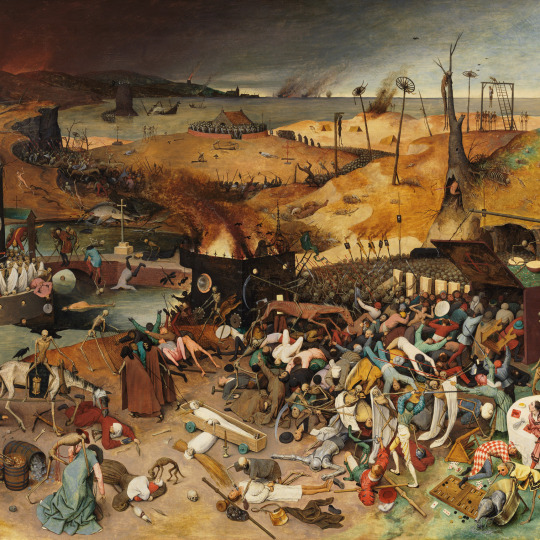
The Bringers of Violence by Ismail Khalidi
"The people of Gaza (as well as Nablus, Jenin, and elsewhere) are teachers and doctors and students, engineers and aunties and babysitters, musicians and footballers and breakdancers. They are preachers and fishermen, weightlifters and storekeepers, lovers and jokesters, bullshitters, birdwatchers and chainsmokers. They are painters and journalists, rappers and barbers and tailors, farmers and fathers, mothers and mechanics and translators. They are policemen and electricians, caretakers, cooks, nurses, poets, firemen, and ambulance drivers; bakers and mathematicians, fighters and surfers and writers, just like you and me and the Israelis whose lives we are told are worth more than theirs. On this point there is no room for equivocation or even discussion. As the Palestinian writer Ghassan Kanafani reminded us, we must know when calls for dialogue and 'peace talks' are just euphemisms for capitulation. Only then can we avoid being drawn into what he calls 'discussions between the neck and the sword.' Only then can we resist the dehumanizing effects of colonialism and racism and move towards equality in all that we do."
Read more at mizna.org
(The Triumph of Death by Pieter Bruegel the Elder, 1562 - 1563. Oil on panel. Museo Del Prado)
#human rights#humanity#equal rights#freedom#peace#free gaza#gaza strip#free palestine#palestine#israel palestine conflict#israel#nablus#jenin#ghassan kanafani#colonialism#mizna.org#women's rights#children's rights#zionistterror#death#pieter bruegel the elder#gaza#poetry#palestinian poetry#nakba#genocide#palestinian genocide
33 notes
·
View notes
Text

Caravaggio: David e Goliat
51 notes
·
View notes
Text

"Aun aprendo", Francisco de Goya y Lucientes (cerca de 1826)
Mi madre tiene en casa un catálogo llamado Tesoros del Prado, de Felipe Vicente Garín Llombart, no debe medir más de seis centímetros de alto y de ancho, con trescientas páginas llenas de ilustraciones a color con obras del museo.
Lo encontré investigando por casa, hay un mueble en lo que siempre hemos llamado "la habitación del ordenador", un recuerdo de una época en la que existía la gran caja blanca debajo de la mesa, con ranura de DVD, con el botón a la altura del dedo gordo del pie y tres tomos del Imperivm para siempre perder creyendo ser Cleopatra.
Nunca he sabido demasiado de historia del arte, pero creo que gran parte de tener la potestad para escribir esto es exactamente eso: estar fuera del estudio teórico, fuera del contexto histórico. No me acuerdo de cuándo fue colocado por primera vez en mi pared, debía ser 2019 o 2020, un momento en el que me afectaba mucho más que ahora pensar en hacerme mayor, en los cambios, en todo lo que quedaba por delante con un terror que ahora miro hacia atrás y pienso "joder, lo adaptable que llegas a ser una vez pasas esos miedos".
Me parece de todo menos trágico, pensaba que aquí iba a escribir sobre el miedo a la vejez (no tanto en mí, sino en mis padres), en el hecho de que mi madre sigue queriendo estudiar, sigue sacándose exámenes, haciendo cursos, cumpliendo objetivos, pero creo que de tanto pensarlo hay cosas de las que no me apetece escribir. Veo el dibujo más como una celebración: puede que pierdas la perspectiva de algo que es temporal, que no tiene remedio, no tengo ninguna razón para escribir sobre el miedo a mi propia vejez, cuando el único miedo lo tengo por las personas más cercanas a mí.
No tengo ni idea, pero tampoco creo que se deba mitificar pinturas por el análisis teórico que se hace de ellas, cuando puede que ni en el momento la persona estuviese realizando tal estudio de su propia obra: categorización, contextos, análisis del trazo, y demás.
En la página web del Museo del Prado se explica que con la obra Goya se refiere a su aprendizaje a volver a caminar, agarrando a dos bastones, inestable y camino a la luz, pero también dice: "En el dibujo Goya nos expresa en primer lugar la soledad del hombre en el tránsito de la vida". Quizá con el tiempo y de tanto mirarlo el anciano del dibujo me devuelve la mirada casi de manera desafiante, incluso cómica: aquí estoy, la vida no ha terminado, es mi primer paso por ella y no he conquistado toda la sabiduría ni me rindo en buscarla, no me voy a sentar a esperar a la muerte porque esté más cerca cada día.
3 notes
·
View notes
Text
Stats 2: Electric Boogaloo
Our 256 works are comprised of.... 132 paintings, 36 drawings / digital artworks / comics, 26 installation pieces, 20 sculptures, 11 buildings, 11 public artworks, 10 photographs, 4 prints, 3 cave arts, 2 textile arts, and 1 thing I classified as a collage instead of anything else!
More stats below!
Most popular city: New York, with 13 pieces, followed by Paris with 8, and Chicago is third with 7! Washington DC has 6, Florence, Madrid, and London all have 5, Philadelphia has 4, Dublin, Edinburgh, Mexico City each have three, and all the following cities have two: Boston, Cairo, Calgary, Cordoba, Helsinki, Houston, Jerusalem, Los Angeles, Munich, Ottawa, Prague, Vienna, Warsaw
Most popular museum: somehow the Art Institute of Chicago has the most with 6 pieces! Followed by the Museum of Modern Art with 5 pieces! The Museo del Prado has 4, the Philadelphia Museum of Art has 3, and the Ateneum, Louvre, Metropolitan Museum of Art, Museo Dolores Olmedo, National Gallery of Canada, Solomon R. Guggenheim Museum, Tate Britain, Tretyakov Gallery, and the Uffizi Gallery each have 2! In addition, the single works are spread out amongst 16 city level galleries (ie the Phoenix Art Museum), 5 state/provincial (ie Queensland Art Gallery), 25 national (ie National Gallery Prague), 8 museums named after benefactors (ie the Hirshhorn Museum), 7 museums dedicated to a specific artist (ie the Van Gogh Museum) and numerous other institutions! Churches, palaces, increasingly specific museums, museums that are named after their location rather than their governmental level... and of course a whole lot of private collections and pieces we were unable to find the location of!
Countries! 50 pieces are in the US! 13 in France! 12 in Spain! 7 in England, 6 in Canada and Italy, 5 in Russia, 4 in Ireland, Mexico, and Australia, 3 each in Germany, Austria, and Scotland, and 2 each in China, the Netherlands, Israel, Finland, Wales, Poland, Japan, Egypt, and India, and 1 each in Portugal, Ecuador, Thailand, Singapore, Belgium, Argentina, Sweden, the Czech Republic, Norway, Bangladesh, Saudi Arabia, and the Vatican!
Demographics! I revoked John Singer Sargents American status for these because he was born in Europe, and spent most of his life travelling around Europe. I tried my best to track down the correct numbers but honestly some of these are likely to be slightly off. I went with easily publicly available information like Wikipedia and where that failed the author's website. I also tracked people's birth countries in addition to where they lived / worked for most of their lives. Anyway! We have 74 pieces by American artists! 27 French, 22 English, 14 Russian, 13 Spanish, 11 Canadian, 9 Italian, 8 Chinese, 8 German, 6 Irish, 6 Polish, 6 Mexican, 5 Greek (four of those are Ancient Greece), 5 Ukrainian, 5 Japanese, 4 Australian, 4 Belgian, 4 Indian, 3 Serbian, 3 Armenian, 3 Dutch, 3 Austria, 3 Latvian, 3 Swedish, 2 each from Finland, Scotland, Malaysia, Cuba, the Czech Republic, and Norway, and one each from Israel (specifically), Portugal, Ecuador, Thailand, Switzerland, Denmark, Iran, Colombia, Chile, Estonia, and Egypt (albeit Ancient Egypt)
Including the one Israeli artist, we have 7 Jewish artists represented, as well as 4 Black, 6 Indigenous (one is half Kichwa, one is Sami, one is Haida, one is Ojibwe, and two are Australian Aboriginals. One of those is Kokatha and Nukunu, and the other one was a group project with eight artists who did the majority of the work, and 6 of those are from Erub Island but the articles did not specify further except that at least one of the eight is non-Indigenous), 1 Chicana, and 1 Asian-American (which I am specifying because I felt very stupid adding tallies to an Asian column when I already said there are 8 Chinese artists and 5 Japanese and 2 Malaysians and....). We also do have 16 artists that publicly identify as queer in some fashion! I have listed 9 works by gay men, 2 works by lesbians, and 5 that have chosen to use "queer" instead of other labels.
And on that note.... we have 155 works by men, 51 by women, and 2 by nonbinary artists!
Most represented artists! Frida Kahlo and René Magritte tied with four works each! Félix González-Torres, Francisco Goya, John Singer Sargent each have three! And the artists that have 2 artworks each are... Claude Monet, Dragan Bibin, Edmund Blair Leighton, Francisco de Zurbarán, Gustav Klimt, Holly Warburton, Hugo Simberg, Ilya Repin, Ivan Aivazovsky, Jacques-Louis David, Jenny Holzer, Louis Wain, Pablo Picasso, Sun Yuan & Peng Yu, Victo Ngai, Vincent van Gogh, Pierre-Auguste Renoir, and Leonardo da Vinci (although the second is debated attribution)! That means that 205 of the works are not by any of the above! Some have unknown artists (we've got THREE CAVE ARTS) but most are just... really varied!
And lastly, years painted (as sorted by year finished and not year started). Who else loves when something is listed as "13th century"?? Not me, that's who. This is going to be a lot of numbers, and there's no real way to make it more readable. so..... feel free to skip!
The oldest two submissions are from circa 40,000 years before present, and 30 to 32 thousand years before present! Six more artworks came to exist before 0 (CE or AD depending on who you're talking to), and 7 before 1000! 2 from the 1200s, 6 from the 1400s, 8 from the 1500s, 3 from the 1600s, and 5 from the 1700s! Several of those already listed were started in a previous ....age category (for instance, one has no specified date other than 7300 BC to 700 AD) but once we hit 1600, everything is usually finished in a relatively short timespan. 6 are from 1800-1850, 9 from 1850-1880, and the 1880s are extremely busy. 1 from 1881, 3 from 1882, 1 from 1883-1885, 5 from 1886, and two each from the next four years (1887-1890)! 6 from 1891-1895, and 5 from 1896-1900!
We've got 3 from 1901 or 1902, 4 from 1903, two each from 1906 and 1907, and one each from 1908 and 1909! 3 from 1910-1915, 3 from 1917, 2 from 1918 and one from 1919! 6 are from the Roaring Twenties, three of them specifically from 1928! 4 from 1931-1935, and only 3 from the latter half of the 30s! There's 3 from WWII, and 4 from 1946-1949, 5 from 1951-1954 but only 3 from '55-'59. 5 from the sixties, 7 spread out through the 70s, and 10 from the 80s, two each from 81, 82 and 84. The 90s have a lot of duplicate and triplicate years, totaling 20 overall! 11 are from 90-95, the other 9 are 96-99. 7 from 2001-2005, and 8 from 2006-2009. 9 from 2010-2014, 3 from 2015, 6 from 2016, 5 from 2017, 1 from 2018, 3 from 2019, 5 from 2020, 1 from 2021, 4 from 2022, 11 from 2023, and 3 ongoing projects! Whew! If anyone wants it listed By Year instead of in groups like this, that'll be most readable in like... list form and that's way too long for a stats post.
Congrats on making it to the end! If you got this far, uh, let me know if you want to see the spreadsheet after the tournament, I guess. I'm very proud of it.
50 notes
·
View notes
Text

María Cristina de las Dos Sicilias
Artist: Vicente López Portaña (Spanish, 1772-850)
Title English: Portrait of Spanish queen-consort Maria Christina of the Two Sicilies.
Genre: Portrait
Date: 1830
Medium: Museo del Prado, Madrid, Spain
Maria Christina of the Two Sicilies
Maria Christina of the Two Sicilies (Italian: Maria Cristina Ferdinanda di Borbone, Principessa delle Due Sicilie, Spanish: María Cristina de Borbón, Princesa de las Dos Sicilias; 27 April 1806 – 22 August 1878) was the queen consort of Spain from 1829 to 1833 and queen regent of the kingdom from 1833, when her daughter became queen at age two, to 1840. By virtue of her short marriage to King Ferdinand VII of Spain, she became a central character in Spanish history for nearly 50 years, thanks to introducing a bicameral model of government based on the Bourbon Restoration in France: the Spanish Royal Statute of 1834.
#portrait#queen consort#spain#Vicente Lopez portana#european#spanish monarchy#19th century painting#woman#princess#queen#jewels#dress#headpiece#veil#spanish painter
11 notes
·
View notes
Text

Hypnerotomachia Poliphili, 1499, page 34: At the beginning of his dream, Poliphilo has a vision of the entire moving Alchemy machine: fourteen discordant dancers taking origin from their opposite. Every man is connected with a woman but untied to her. Every smiling face turns into a crying face. But every simile restarts from a dissimilar. Like night and day. Summer and Winter. Sun and Moon. Philosophical time needs rhythm and pace, while alchemical time demands strict proportions.
One of the best-known engravings from Hypnerotomachia Poliphili is undoubtedly that of the enigmatic bi-faced group of dancers. We are still in the incipit of the first book. When walking out of the dark forest, having been drinking at the river, Poliphilo enters the huge pyramid to see some wonders. After a winged horse with putti and two squared stone pillars, he can glaze at a group of men and women with two faces. One smiling, the other crying. He was dancing in two oscillating semi-circles, not in a round.
From the quaint (even for a Venetian) language, which is not quite Latin and neither Italian in which Hypnerotomachia Poliphili has been written: "sul lato destro da poscia coelate erano alcune figure di homini & di damigelle chorigianti, cum due facie per uno. Quella dinanti ridibonda, la posteriora lachrymosa" On the right side were some presences of dancing young men and young ladies, each with two faces. The front one is smiling; the back one is crying. And in the round, they were dancing, holding my arms, a man with man and woman with a woman—a man’s arm under a woman’s, and the other arm over the woman’s one. And so holding, they move in that way, one by one. That is always one happy face as opposed to the sad face of the previous. There were seven and seven of them, so perfectly carved of ancient sculpture, with living movements and flying garments. They didn’t burden the artist with any other inaccuracy than not giving them voice and tears. The dance, as mentioned earlier, was shaped in two semi-circles and an interposed partition, egregiously scratched.
This forms the predicate for Peter Paul Rubens' Dance of Mythological Figures and Villagers (Antwerp, 1630–35), Museo de Prado, Madrid.
[Robert Scott Horton]
+
“The true alchemists do not change lead into gold; they change the world into words.” ― William H. Gass, A Temple of Texts
+
“Water: 35 liters, Carbon: 20 kg, Ammonia: 4 liters, Lime:1.5 kg, Phosphrus: 800 g, salt: 250g, saltpeter:100g, Sulfer: 80g, Fluorine: 7.5 g, iron: 5.6 g, Silicon: 3g, and 15 other elements in small quantities.... thats the total chemical makeup of the average adult body. Modern science knows all of this, but there has never been a single example of succesful human trasmutation. It's like there's some missing ingredient..... Scientists have been trying to find it for hundreds of years, pouring tons of money into research, and to this day they don't have a theory. For that matter, the elements found in a human being is all junk that you can buy in any market with a child's allowence. Humans are pretty cheaply made.” ― Hiromu Arakawa, Fullmetal Alchemist, Vol. 1
8 notes
·
View notes